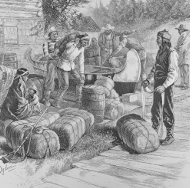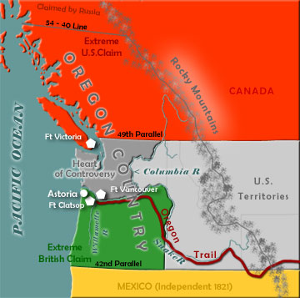The Oregon Treaty
The Oregon Treaty resolved a boundary dispute between Great Britain and the U.S. in the Pacific Northwest. The Louisiana Purchase in 1803 essentially doubled the size of the United States, adding large swathes of territory to the growing America. The land that France sold to the U.S. was large, but it didn't include the Oregon Territory. 
Russian explorers and settlers had been in the area of what is now Oregon for many years. British explorers, among them Captain James Cook, had been through the area as well, and British settlers were, in some cases, ensconced in the area. American settlers as well were in the area, their numbers growing after the Lewis and Clark expedition had explored the area in 1804 and 1805. Adding to the American presence was a fur trading post owned by John Jacob Astor, the magnate that, among other things, ran the Pacific Fur Company. Spain had been in the picture as well but had signed away its claims to the area in 1819. A year before that, representatives of Great Britain and the U.S. hammered out an agreement on the Canada-U.S. border, the Convention of 1818, that set that border as the 49th parallel. That agreement didn't include the Oregon Territory, which both countries agreed to continue to own jointly for another 10 years. The meeting a decade later produced no willingness to assign the territory to one country over another; meanwhile, more and more Americans were setting up homesteads there. The 1842 Webster-Ashburton Treaty had settled disputes in the northeast U.S., over the Maine-New Brunswick border, but no discussions of the Oregon Territory took place. 
In 1843, American demands for an all-American settlement of the Oregon Territory grew considerably, with hundreds arriving every year along the Oregon Trail. Many Americans wanted to set the boundary at 54 degrees 40 minutes, meaning that the U.S. would take ownership of the entirety of the Oregon Territory, even that then owned by Great Britain. A slogan heard in many places around the country during the 1844 presidential and congressional campaigns was "54 40 or fight," meaning that they were prepared to go to war with Great Britain over the boundary, if necessary. James K. Polk was was elected President that year. Eager to settle the matter, Polk proposed that the two countries set the 49th parallel as the boundary. Secretary of State James Buchanan and British Minister to Washington Richard Pakenham sealed the deal. One of the minor modifications to the initial proposal was the designation of Vancouver Island as entirely within the purview of Canada. The U.S. Senate ratified the treaty by a healthy margin on June 18, 1846. |
|
Social Studies for Kids
copyright 2002–2025
David White




